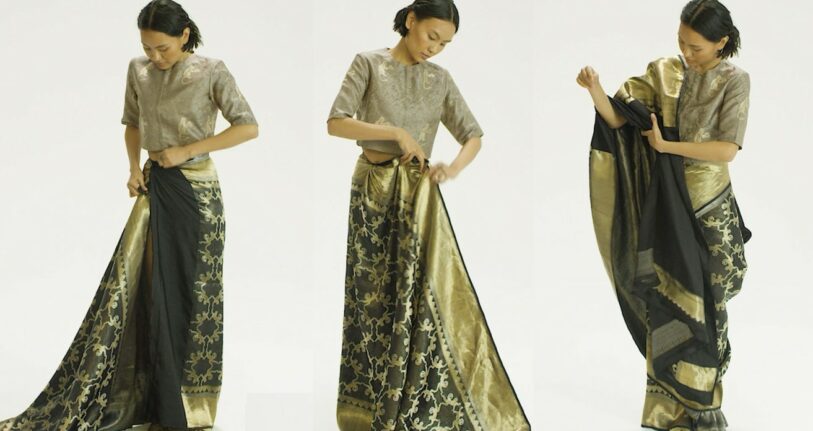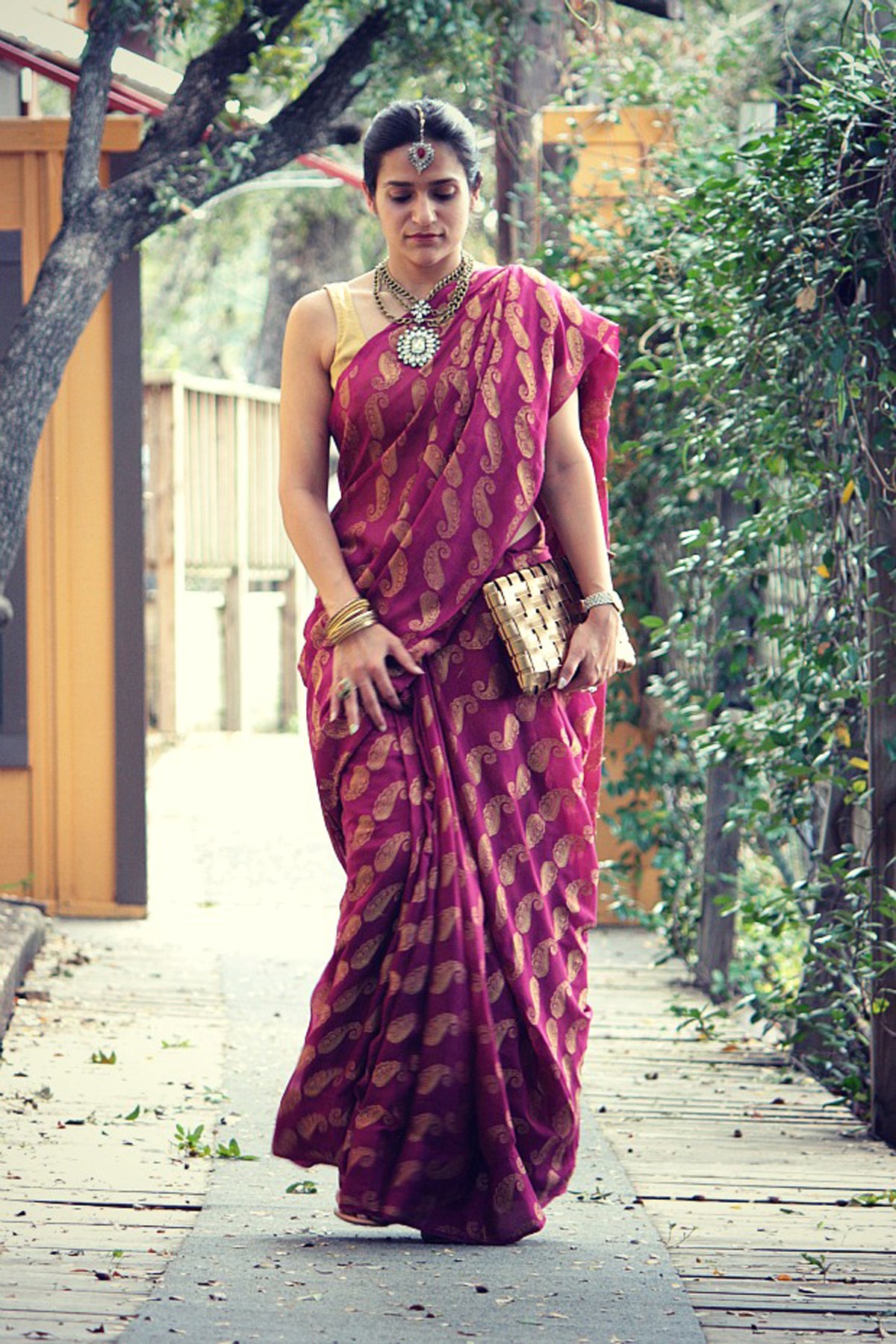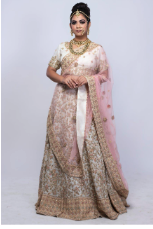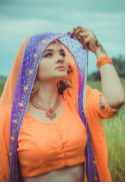Discover the Rich History of the Sari and Draping Styles

The Rich History of the Sari and Draping Styles
Introduction to the Sari and Draping Styles
No other single piece of drape looks so complete when worn, other than the humble sari. No wonder then that this simple yet elegant garb is admiringly called the ‘The Six-Yard Wonder.’ A timeless wonder!
The sari truly has stood the test of time, with its advent dating back to the Indus Valley Civilization (2800 – 1800 BC). Current trends in sari draping offers a nice blend of Indian and international styles that are frequently showcased at high end fashion shows and exhibitions.
The name of this garment evolved from the word ‘sattika’ (meaning a women’s attire), and appears in early Jain and Buddhist scriptures. This consisted of a three-piece ensemble – Antriya – the lower garment, Uttariya – a veil worn over the shoulder or the head, and the Stanapatta – a chest band. This three-piece set was known as Poshak, the Hindi term for costume. The ‘dhoti’ worn by men, was perhaps the precursor to the Antriya, as this resembled a dhoti or the fishtail style of tying a sari. From here on, this dressing style evolved into a ‘Bhairnivasani’ or skirt, which later came to be known as ‘ghagra’ or ‘lehenga.’ Uttariya evolved into dupatta and Stanapatta, into the choli.
Women in India (read Jhansi, UP) as chronicled in history, found the dhoti style of tying saris (or saris tucked between the legs), convenient, while they rode horses and swam in rivers and ponds. The traditional Maharashtrian style of draping saris is similar to this, and we can see fisherfolk from here draped in dhoti-styled saris, as the they set about their work.
The sari is a long 5.5 to 8 metre piece and around 1 metre wide, and is most commonly worn by wrapping one end around the waist followed by pleats displayed in front, full-length from waist downwards. The other end of the piece is draped over the shoulder. The blouse came into existence with the Mughals and the British. This along with the petticoat have been carried over to the modern. Thus, sari is the perfect garment to enhance the beauty of women in the sub-continent.
Different Styles of Sari
India’s diversity is seen in the entire range of saris with their geographic and ethnic roots, apart from the myriads of colours, weaves, textures and patterns options. Every region has a unique way of draping the sari and is distinct and identifiable. Styles too are associated with different geographical regions of India.
The regional names associated with silk, Ikat, and cotton saris are listed below alongside the names of the states they are natives of: –
PATOLA | GUJERAT |
POCHAMPALLY | TELANGANA |
BOMKAI | ODISHA |
KHANDUA | ODISHA |
SAMBALPURI | ODISHA |
BENARASI | VARANASI, UP |
BEHRAMPURI | ODISHA |
BARGARH | ODISHA |
JAMDANI | ORIGIN: BANGLADESH |
TANT | BENGAL |
MANGALGIRI | ANDHRA PRADESH |
GUNTUR | ANDHRA PRADESH |
NARAYANPET | MAHARASHTRA |
CHANDERI | MADHYA PRADESH |
MAHESHWARI | MADHYA PRADESH |
NUAPATNA | ODISHA |
TUSSAR | BENGAL, BIHAR |
KODPAD | TRIBAL ODISHA |
MANIPURI | MANIPUR |
BANDHANI | RAJASTHAN |
LEHERIA | RAJASTHAN |
BAGRU | RAJASTHAN |
AJRAKH | GUJERAT (KUTCH) |
SUNGUDI | TAMIL NADU |
KOTA | RAJASTHAN |
KALAMKARI | ANDHRA PRADESH (Antique art) |
BALUCHARI | BENGAL |
Tie-dyed and block-print saris known as Bandhani, Leheriya, Bagru, Ajrakh, Sungudi, Kota, and Kalamkari are native to states like Gujerat, Rajasthan, and Tamil Nadu. These have prints and patterns easily identifiable with the region they originally come from.
Tie-dyed and block-print saris known as Bandhani, Leheriya, Bagru, Ajrakh, Sungudi, Kota, and Kalamkari are native to states like Gujerat, Rajasthan, and Tamil Nadu. These have prints and patterns easily identifiable with the region they originally come from.
Handloom saris across India, made from silks, cotton, ikat, block-prints, embroidered, and in tie-dye prints are popular, and worn on formal or casual occasions. The expensive weaves are in brocade silk and the regional best include – Banarasi (UP), Kanchipuram (TN), Gadwal (AP) Paithani (MH), Mysore (Karnataka) Uppada (AP), Bhagalpuri (Bihar), Baluchari (WB), Maheshwari (MP), Chanderi (MP), Mekhela (ASSAM), Ghicha (WB), Narayanpet (TELENGANA) and the list goes on! These are worn on special occasions like wedding, festivals and any celebrations observed, and are representative of the states they come from.
With the import of chemical dyes new techniques of dyeing and printing textiles was developed and added a whole new rendition of saris and sari options.
Industrialisation development saw wealthy Indians get artisans to embellish saris with expensive stones, gold thread work (zari) to give a rich luxurious look and feel to the saris. Gota Patti or traditional embroidery is for a formal look. Other folk embroidery methods used are mochi, pakko, kharak, suf, kathi, phulkari and gamthi. Modern fabrics like polyester, georgette, charmeuse and the French Chiffon have been in vogue for a while.
Over the ages, draping styles have become varied and have evolved from traditional, royal, modern, boho-chic and landed on the catwalks of high-end fashion!
The Evolution of the Sari and Draping Techniques
The commonly used style of draping is the Nivi style. Iconic, represents the look of traditional Indian woman. This has its origins in the Deccan region. The sari is worn with a fitted bodice or a choli and a petticoat, called ghagra, parkar, or ul-pavadai.


Nivi Style Draping –This is the most popular traditional draping style. A universal and versatile style that never goes out of fashion!
The modern-day style of sari draping can be attributed to Gyanodanandini, (wife of Satyendranath Tagore, the elder brother of Rabindranath Tagore). Her pioneering sari wearing, was influenced by the Parsi style adopted during her stay in Bombay where her husband was posted.

Belted Sari Draping– Handed down from ancient times, this vintage style of accessorizing the sari with a Kamarpatta, was in fashion during 60’s and 70’s era. Originally a gold or carved metal belt. Could be made of leather, beads, fabric and is worn around the waist over the sari.
Belted Sari Draping– Handed down from ancient times, this vintage style of accessorizing the sari with a Kamarpatta, was in fashion during 60’s and 70’s era. Originally a gold or carved metal belt. Could be made of leather, beads, fabric and is worn around the waist over the sari.

Retro Style Sari Draping –Actress Mumtaz especially from the Indian film industry did much to popularise this draping style… also known as the ‘wrap around’ style. The sari has a narrow border and has 3 layering without the usual pleats.


Neck Drape style– Sari is worn by wrapping pallu around the neck like a scarf – for a funky look.


Gujarati Style Sari Draping –Typically associated with Gujerat, where the pallu is taken from the back and brought over the right shoulder and is spread across the chest. Style also followed in states like Rajasthan, Bihar, Jharkhand and North India.

Jacket over Sari Draping –Sporting a jacket with the sari for a contemporary look has hit the right notes with fashion designers. For a smart- casual, modern and/or formal look.


Pant Style Sari Draping –Current and trendy, when you team the sari with pants or jeggings.

Mermaid Style Draping– This style gives a flattering look and is distinctive style sari will have close fitting at the hip section and flared out at hem


Marathi / Laavani Style– Traditional Maharashtra sari measures 8 metres. One portion of the sari is lifted up between the legs and tucked behind at the waist, while another portion is draped as a pallu over the shoulder.


Bengali Style – Traditional Bengali sari will be in white in colour red border. Wide box pleats are tucked at front and pallu is taken over the left shoulder

Coorgi or Kodagu Style– This is unique, where pleats are created at the back for free movement of the legs. The pallu is wrapped around the front chest and brought over the shoulder from the back

Oriya Style– Follows the same basic pleating procedure for the lower body and pin the pleated pallu on left shoulder.


Lehenga Style Sari Draping – popular in North India

Rajrani Style Sari Draping – As the royals did it!


Kerala Style– This traditional attire will have colour ranging from pure white to cream with a gold border Sari consists of two- piece cloth. Mundu is draped on the lower part of the body, while neriyathu is worn over the left shoulder.

Tamilian Iyer Style – Usually bordered saris, wrapped around the waist, the pleats are positioned at left waistline. Rest of the sari is taken over the shoulder and wrapped again around the waist.



Rajasthani Style and Bandhni and Leheriya patterned on sari and ghagra choli, in brilliant colours

Enkei Style – This is typical Andhra Pradesh attire, where the lower part is made to look like a dhoti. Pleats are tucked at the back of waist. Pallu is pulled over shoulder and wrapped around the waist.


Assam Style Sari Draping – This sari type is known as mekhla chadar and composed of two pieces. Mekhla is the flowing skirt and Chadar is the upper wrap called Riha similar to Anchal. The chadar is worn in a criss-cross pleated-form down the front side.


Chattisgarh Style – Here the sari draping is very different from all other and quite unusual and interesting!


Dhoti Style sari draping draws inspiration from Maharashtra. After draping sari around the waist, the longer section is brought from the back to the front, with three-to-four-inch pleats. Distinct feature are the cowls that pass from front under the leg, for a dhoti finish!
Sari draping styles have further evolved from the basic Nivi style and elements of western cuts and designs, to include the Indo-western style, skirt style, short Patli style, Half- float half- tucked style, the Tee or Tunic style, and many more styles that creativity and imagination allow. The charm and beauty of the world’s oldest garment the sari, will live to enhance the look of women, and enchant one and all!






